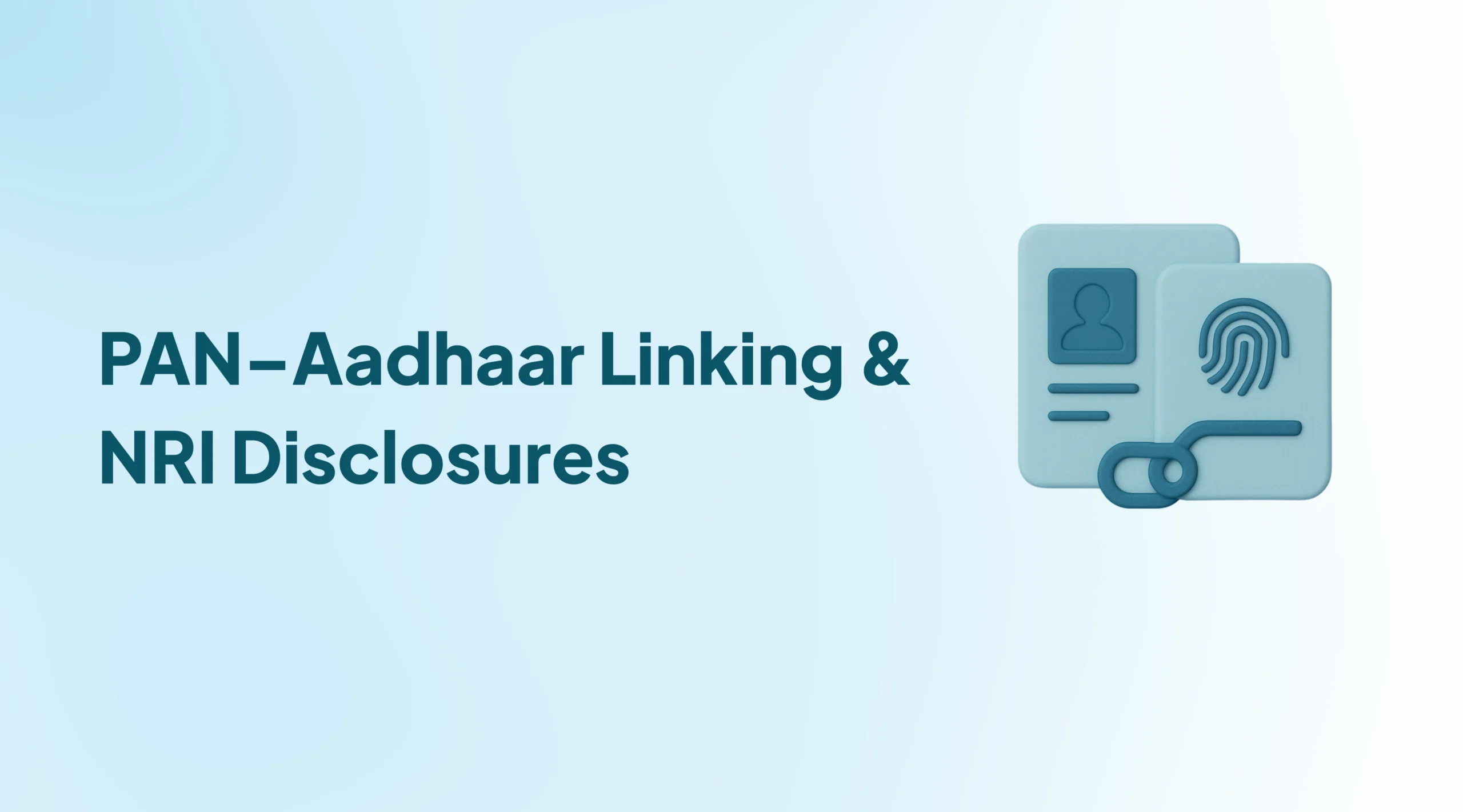If you’re an NRI, chances are you’ve either heard stories of friends having their PAN marked inoperative or you’ve faced the nightmare yourself. One day you try to redeem mutual funds or file a return, and suddenly the system blocks you. Your investments freeze. Refunds get stuck. The culprit? PAN–Aadhaar linking rules and missed disclosures.
This guide will clear the confusion. By the end, you’ll know:
- When PAN–Aadhaar linking is mandatory and when it isn’t.
- What exemptions exist for NRIs.
- What happens if your PAN becomes inoperative.
- How to update your residency status from abroad.
- Other mandatory disclosures every NRI must make.
- A practical checklist you can download and use.
Think of this as your all-in-one compliance map.
Is PAN–Aadhaar Linking Mandatory for NRIs?
Let’s start with the law.
Under Section 139AA of the Income Tax Act, 1961, any individual eligible to obtain Aadhaar must quote it:
- In their PAN application.
- And while filing their Income Tax Returns (ITR) in India.
Sounds straightforward, right? But here’s where it gets tricky.
As an NRI, you are not required to obtain Aadhaar. That’s the official position. The Income Tax Department clarified that if you’re a non-resident under Indian tax law, the linking requirement doesn’t apply.
However, if you already got an Aadhaar card (maybe while you lived in India before moving abroad), the system assumes you should link it. If you don’t, your PAN risks becoming inoperative.
2025 update: From July 1, 2025, Aadhaar will be mandatory for all new PAN applications. Even NRIs applying for a fresh PAN will need Aadhaar at the time of application.
So, in short:
- No Aadhaar, no linking required.
- Have Aadhaar? You must link it.
Exemptions: When NRIs Don’t Need to Link
The government carved out clear exemptions back in 2017. These still stand today.
You are exempt from linking PAN and Aadhaar if you fall into one of these categories:
- An NRI who does not hold Aadhaar.
- A resident of Assam, Meghalaya, or Jammu & Kashmir.
- Senior citizens above 80 years at any time during the year.
- Foreign citizens (including OCI and PIO holders).
Think of it like airport security. If you’re not on the “mandatory passenger list,” you don’t need to clear that gate.
But remember, if you already have Aadhaar, even as an NRI, the exemption may not apply automatically. That’s why updating your NRI status on the IT portal is so important.
What Happens If Your PAN Becomes Inoperative?
Here’s where the pain starts. An inoperative PAN is not just an inconvenience. It’s a full stop on your financial life in India.
If your PAN is marked inoperative:
- Higher TDS and TCS: Taxes deducted at source (TDS) shoot up to 20% or more. Taxes collected at source (TCS) also double.
- Refunds blocked: Pending refunds are frozen. No interest accrues during the inactive period.
- Investments disrupted: Mutual fund houses won’t process new SIPs or redemptions. Property sales hit snags. Even bank KYC fails.
- NRO accounts affected: Rental income, dividend payouts, and even withdrawals become messy.
Example:
Imagine you sold a property for ₹1 crore. Normally, with proper PAN status, TDS could be managed at a lower rate. With an inoperative PAN, the buyer must deduct 20% straight away — that’s ₹20 lakh gone before you even blink.
How to Update NRI Residency Status on the Income-Tax Portal
This is where many NRIs trip up. Filing returns as an NRI is not enough. Unless you manually update your status on the IT portal, the system may still treat you as resident.
Here’s how to fix it:
- Log in to the Income Tax portal.
- Go to your Profile Section.
- Select Basic Details → Residential Status.
- Change to Non-Resident.
- Upload proof:
- Self-attested passport copy.
- Visa/residence permit.
- Details of days stayed outside India.
- Save and confirm.
Pro tip: If you’re unsure how many days you’ve stayed in India vs abroad, use a simple Excel tracker. Many NRIs underestimate their “days in India” and end up with the wrong status.
Common mistakes to avoid:
- Not attaching all pages of your passport showing entry/exit stamps.
- Submitting without proof of your foreign address.
- Assuming your bank updated NRI status also updates IT portal. (It doesn’t.)
Steps to Reactivate an Inoperative PAN (With or Without Aadhaar)
If your PAN has already turned inoperative, don’t panic. You have two ways to revive it.
Option 1: Update Your NRI Status
- Submit passport and PAN copy to your Jurisdictional Assessing Officer (JAO).
- Attach details of your stay abroad.
- Once verified, your PAN becomes active again. This process can take up to 30 days.
Option 2: Link PAN with Aadhaar
- If you have Aadhaar, go to the Income Tax portal.
- Pay the late fee of ₹1,000.
- Complete linking process.
- PAN becomes operative within 30 days of linking.
Think of it like restarting a phone. You either reset the settings (update status) or reconnect it to the network (link Aadhaar). Either way, it comes back online.
Other Mandatory Disclosures & NRI Tax Compliance Essentials
PAN–Aadhaar linking is only one piece of the puzzle. NRIs have other compliance responsibilities too.
Schedule FA (Foreign Assets)
If you own foreign assets — bank accounts, shares, real estate — you must disclose them in Schedule FA while filing ITR.
Bank Account Details
Refunds are only processed to bank accounts linked with PAN. NRIs should ensure at least one NRO/NRE account is updated on the IT portal.
FATCA and CRS Declarations
If you invest in mutual funds or open bank accounts, you’ll be asked to declare under FATCA/CRS. This ensures automatic information exchange with your country of residence.
Residential Status Declaration
Every year, NRIs must compute their residency (based on 182-day rule) and declare it. This determines whether global income is taxable in India.
ITR Forms for NRIs
Most NRIs file using ITR-2 or ITR-3. Using the wrong form can delay processing and refunds.
FAQs
Can an NRI file ITR with an inoperative PAN?
Yes, you can file, but refunds won’t be issued and TDS will be cut at a higher 20% rate until the PAN is reactivated.
What’s the penalty for missing the PAN–Aadhaar deadline?
You must pay a late fee of ₹1,000. Until linking or status update is done, PAN stays inoperative, refunds remain blocked, and TDS/TCS are deducted at higher rates.
Is linking required to invest in India?
Only if you already hold Aadhaar. If you don’t, update your NRI status on the IT portal so your PAN isn’t wrongly marked inoperative.
What documents are needed to change NRI status?
Self-attested copies of PAN, passport (with travel stamps), visa or residence permit, and proof of foreign stay/address.
Does PAN–Aadhaar affect mutual fund investments?
Yes. Fund houses freeze SIPs, redemptions, and dividend payouts if PAN is inactive.
Is linking of PAN and Aadhaar mandatory for NRI?
No, unless you already have Aadhaar. NRIs without Aadhaar are exempt.
Do OCI need to link PAN with Aadhaar?
No. OCIs are foreign citizens, so Aadhaar rules don’t apply.
Can NRI get PAN card without Aadhaar card?
Yes, until June 2025. From July 2025, Aadhaar will be mandatory for all new PAN applications.
Who is exempted from PAN–Aadhaar linking?
NRIs without Aadhaar, residents of Assam/Meghalaya/J&K, individuals above 80 years, and non-citizens (including OCI/PIO).
How to update the resident status of PAN for an NRI?
Log in to the IT portal → Profile → Basic Details → change to Non-Resident → upload passport/visa. Or submit documents to your Jurisdictional Assessing Officer.
Conclusion
For NRIs, PAN–Aadhaar linking is less about the card and more about the consequences. Inoperative PAN means higher taxes, blocked investments, and unnecessary stress.
The good news? With the right steps — updating your NRI status or linking Aadhaar if you have one — you can keep your PAN active and your finances safe.
Remember: PAN is your financial passport in India. Don’t let it expire in the system.


0 Comments